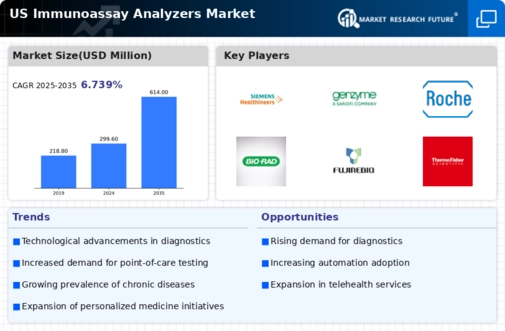Growing Focus on Personalized Medicine
The shift towards personalized medicine is emerging as a crucial driver for the immunoassay analyzers market. As healthcare providers increasingly recognize the importance of tailoring treatments to individual patient profiles, the demand for precise diagnostic tools has intensified. Immunoassay analyzers play a pivotal role in identifying specific biomarkers that guide therapeutic decisions. The market for personalized medicine in the US is projected to reach $2 trillion by 2025, indicating a robust growth trajectory. This trend is likely to stimulate the adoption of immunoassay technologies, as they enable healthcare professionals to deliver targeted therapies based on individual patient characteristics. Consequently, the immunoassay analyzers market is poised for expansion as the healthcare landscape evolves towards more personalized approaches to treatment.
Increasing Prevalence of Chronic Diseases
The rising incidence of chronic diseases such as diabetes, cardiovascular disorders, and autoimmune conditions is a primary driver for the immunoassay analyzers market. As these diseases require regular monitoring and management, healthcare providers are increasingly adopting immunoassay technologies for accurate diagnostics. According to recent data, chronic diseases account for approximately 70% of all deaths in the US, highlighting the urgent need for effective diagnostic tools. This trend is likely to propel the demand for immunoassay analyzers, as they offer rapid and reliable results, facilitating timely clinical decisions. The growing patient population necessitates enhanced testing capabilities, thereby driving investments in advanced immunoassay technologies. Consequently, the immunoassay analyzers market is expected to experience substantial growth as healthcare systems adapt to the increasing burden of chronic diseases.
Rising Awareness of Preventive Healthcare
The increasing awareness of preventive healthcare is significantly impacting the immunoassay analyzers market. As individuals and healthcare providers recognize the importance of early detection and prevention of diseases, the demand for diagnostic testing is on the rise. Public health campaigns and educational initiatives have contributed to a heightened understanding of the benefits of regular health screenings. In the US, the preventive healthcare market is expected to grow at a CAGR of 5% over the next few years. This growing emphasis on preventive measures is likely to drive the adoption of immunoassay analyzers, as they provide essential information for early diagnosis and intervention. Consequently, the immunoassay analyzers market is anticipated to benefit from this shift towards proactive healthcare strategies.
Expansion of Research and Development Activities
The immunoassay analyzers market is significantly influenced by the expansion of research and development (R&D) activities in the healthcare sector. Increased funding for biomedical research, particularly in diagnostics and therapeutics, has led to innovations in immunoassay technologies. In the US, federal and private investments in healthcare R&D have surged, with expenditures reaching over $200 billion annually. This influx of capital fosters the development of novel immunoassay platforms that enhance sensitivity, specificity, and throughput. As researchers seek to explore new biomarkers and disease pathways, the demand for advanced immunoassay analyzers is likely to rise. Furthermore, collaborations between academic institutions and industry players are expected to accelerate the introduction of cutting-edge technologies, thereby propelling the growth of the immunoassay analyzers market.
Advancements in Automation and Workflow Efficiency
The immunoassay analyzers market is being driven by advancements in automation and workflow efficiency within laboratory settings. As laboratories strive to enhance productivity and reduce turnaround times, automated immunoassay analyzers are becoming increasingly popular. These systems streamline the testing process, minimize human error, and allow for higher sample throughput. In the US, the demand for automation in laboratories has grown, with an estimated 30% of laboratories adopting automated solutions in recent years. This trend is likely to continue, as healthcare facilities seek to optimize their operations and improve patient outcomes. The integration of automation in immunoassay analyzers not only enhances efficiency but also supports the growing volume of tests required in clinical diagnostics, thereby driving the market forward.



















Leave a Comment